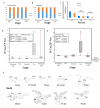Heterogeneity in the formation of primary and secondary visual fields during human prenatal development
- PMID: 39609712
- PMCID: PMC11603890
- DOI: 10.1186/s40659-024-00576-0
Heterogeneity in the formation of primary and secondary visual fields during human prenatal development
Abstract
The human neocortex has a huge surface area with unique cytoarchitectonics, most of which is concealed in sulci. Some cytoarchitectonic fields are associated with macroscopic landmarks. In particular, the primary visual field 17 is associated with the calcarine sulcus. During the prenatal development of the human brain, neocortical gyri and sulci undergo changes and modifications after primary formation. To explore the morphogenetic processes in visual fields during the formation of the primary (provisional) and secondary (permanent) sulci, the occipital lobe of the human fetal brain was studied using immunohistochemical methods. The distribution of various glial and neuronal markers (S-100, β-III-tubulin, NeuN, reelin) in the calcarine sulcus and parietooccipital sulcus was compared. The heterogeneity in the formation of primary and secondary visual fields was demonstrated. The study revealed that the development of the primary visual field 17, linked with the calcarine sulcus, preceded the development of a shared anlage of fields 18 and 19 linked with the parietooccipital sulcus. The functional differentiation of the primary visual field begins during the period of thalamic afferent ingrowth. This process coincides with the temporal smoothing of the calcarine sulcus, indicating a simultaneous progression of functional specialization and structural modifications. At the late fetal period, cortical plate of gyri and sulci banks showed higher NeuN-labeling than inside the sulcus in the same cytoarchitectonic field.
Keywords: Calcarine sulcus; Gyrification; Human fetal development; Human fetuses; Occipital lobe; Parietooccipital sulcus; Visual fields.
© 2024. The Author(s).
Conflict of interest statement
Declarations. Ethics approval and consent to participate: The study was conducted in accordance with the Declaration of Helsinki. All protocols were approved by the local Ethics Committee of the Research Institute of Human Morphology(No. 3, January 17, 2006; No. 33(9), February 7, 2022). Informed consent: Not applicable. Conflict of interest: The authors declare no conflict of interest. The funders had no role in the design of the study; in the collection, analyses, or interpretation of data; in the writing of the manuscript; or in the decision to publish the results.
Figures









Similar articles
-
Fetal sulcation and gyrification in common marmosets (Callithrix jacchus) obtained by ex vivo magnetic resonance imaging.Neuroscience. 2014 Jan 17;257:158-74. doi: 10.1016/j.neuroscience.2013.10.067. Epub 2013 Nov 9. Neuroscience. 2014. PMID: 24220690
-
Is the length of the calcarine sulcus associated with the size of the human visual cortex? A morphometric study with magnetic resonance tomography.J Hirnforsch. 1995;36(4):451-9. J Hirnforsch. 1995. PMID: 8568215
-
How early are fetal cerebral sulci visible at prenatal ultrasound and what is the normal pattern of early fetal sulcal development?Ultrasound Obstet Gynecol. 2004 Dec;24(7):706-15. doi: 10.1002/uog.1802. Ultrasound Obstet Gynecol. 2004. PMID: 15586358
-
Study of fetal and postnatal morphological development of the brain sulci.J Neurosurg Pediatr. 2013 Jan;11(1):1-11. doi: 10.3171/2012.9.PEDS12122. Epub 2012 Nov 9. J Neurosurg Pediatr. 2013. PMID: 23140215
-
[Echographic aspects of cerebral sulci in the ante- and perinatal period].J Radiol. 1988 Aug-Sep;69(8-9):521-32. J Radiol. 1988. PMID: 3057186 Review. French.
References
-
- Letinic K, Zoncu R, Rakic P. Origin of GABAergic neurons in the human neocortex. 2002;645–9. - PubMed
-
- Rakic P. Mode of cell migration to the superficial layers of fetal monkey neocortex. J Comp Neurol. 1972;145:61–83. - PubMed
-
- Schmechel DE, Rakic P. Arrested proliferation of radial glial cells during midgestation in rhesus monkey. Nature. 1979;277:303–5. - PubMed
MeSH terms
Substances
Grants and funding
LinkOut - more resources
Full Text Sources

